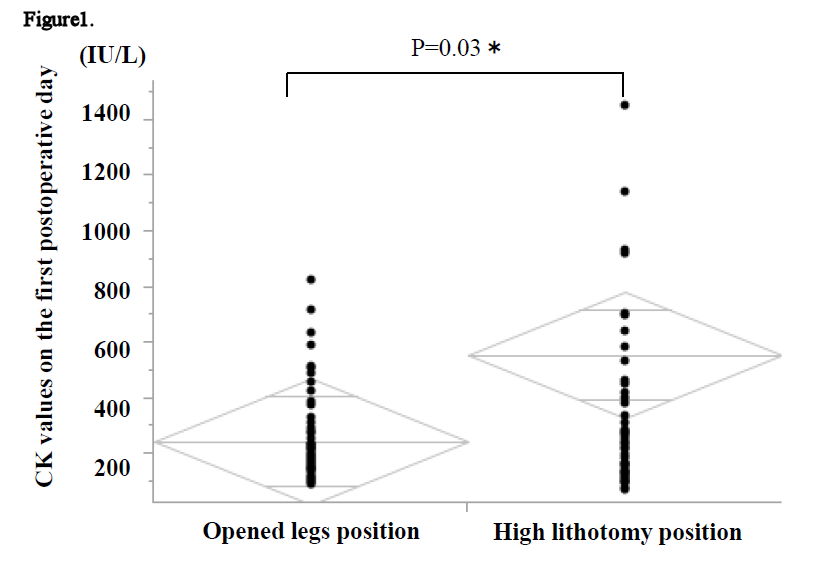Back
Poster, Podium & Video Sessions
Moderated Poster
MP15: Prostate Cancer: Localized: Surgical Therapy I
MP15-12: Efficacy of the Opened Legs Position for Preventing Postoperative Rhabdomyolysis after Robot-Assisted Radical Prostatectomy(RARP)
Friday, May 13, 2022
2:45 PM – 4:00 PM
Location: Room 222
Hiroshi Matsuzaki*, Kazuna Tsubouchi, Naotaka Gunge, Takeshi Miyazaki, Yu Okabe, Nobuyuki Nakamura, Hirofumi Matsuoka, Nobuhiro Haga, fukuoka-shi, Japan

Hiroshi Matsuzaki Matsuzaki, MD
Fukuoka university hospital
Poster Presenter(s)
Introduction: RARP has become the gold standard surgical treatment for localized prostate cancer. However, RARP is performed in the exaggerated high lithotomy position with a steep 23-25-degree head-down position. As a result, there have been several reports of rhabdomyolysis after surgery.
The aim of the present study was to clarify the relationships of intraoperative surgical position with the incidence of postoperative rhabdomyolysis.
Methods: The participants in the present study were 276 consecutive patients who underwent RARP at our institutions between 2013 and 2020. Of the 276 cases, 130 were performed in the opened legs position and 146 in the high lithotomy position with a steep 23-25-degree head-down position. Rhabdomyolysis was defined as CK values greater than 1000 IU/L. Propensity score-matching including the variables age, BMI, presence or absence of comorbidities, preoperative CK, preoperative eGFR, and PSA was performed, resulting in a matched cohort of 146 patients (opened legs position group n=73; high lithotomy position group n=73, Table1).
Results: After propensity score-matching, CK values on the first day after surgery were significantly lower in the opened legs position group than in the high lithotomy position group (opened legs position group: high lithotomy position group = 246.9 ± 114.9 IU/L: 558.2 ± 114.9 IU/L, P = 0.034, Figure1). Significantly fewer patients were diagnosed with postoperative rhabdomyolysis in the opened legs position group (opened legs position group: high lithotomy position group = 0% (0/73): 9.6% (7/73), P < 0.001). In addition, fluid replacement volume was significantly less in the opened legs position group (opened legs position group: high lithotomy position group = 5747 ± 180 mL: 6349 ± 0176 mL, P = 0.018).
Conclusions: In the present study, rhabdomyolysis occurred significantly less in the opened legs position group than in the high lithotomy position group. In terms of preventing rhabdomyolysis after surgery, RARP should be performed in the opened legs position.
Source of Funding: none.


The aim of the present study was to clarify the relationships of intraoperative surgical position with the incidence of postoperative rhabdomyolysis.
Methods: The participants in the present study were 276 consecutive patients who underwent RARP at our institutions between 2013 and 2020. Of the 276 cases, 130 were performed in the opened legs position and 146 in the high lithotomy position with a steep 23-25-degree head-down position. Rhabdomyolysis was defined as CK values greater than 1000 IU/L. Propensity score-matching including the variables age, BMI, presence or absence of comorbidities, preoperative CK, preoperative eGFR, and PSA was performed, resulting in a matched cohort of 146 patients (opened legs position group n=73; high lithotomy position group n=73, Table1).
Results: After propensity score-matching, CK values on the first day after surgery were significantly lower in the opened legs position group than in the high lithotomy position group (opened legs position group: high lithotomy position group = 246.9 ± 114.9 IU/L: 558.2 ± 114.9 IU/L, P = 0.034, Figure1). Significantly fewer patients were diagnosed with postoperative rhabdomyolysis in the opened legs position group (opened legs position group: high lithotomy position group = 0% (0/73): 9.6% (7/73), P < 0.001). In addition, fluid replacement volume was significantly less in the opened legs position group (opened legs position group: high lithotomy position group = 5747 ± 180 mL: 6349 ± 0176 mL, P = 0.018).
Conclusions: In the present study, rhabdomyolysis occurred significantly less in the opened legs position group than in the high lithotomy position group. In terms of preventing rhabdomyolysis after surgery, RARP should be performed in the opened legs position.
Source of Funding: none.

.jpg)
.jpg)